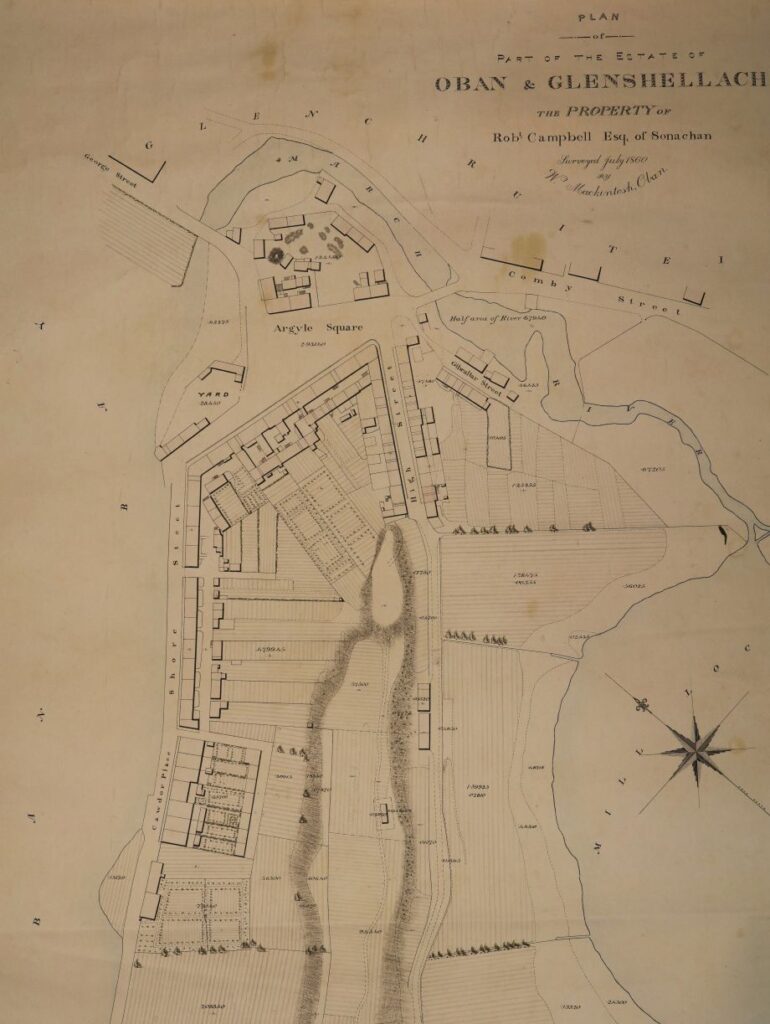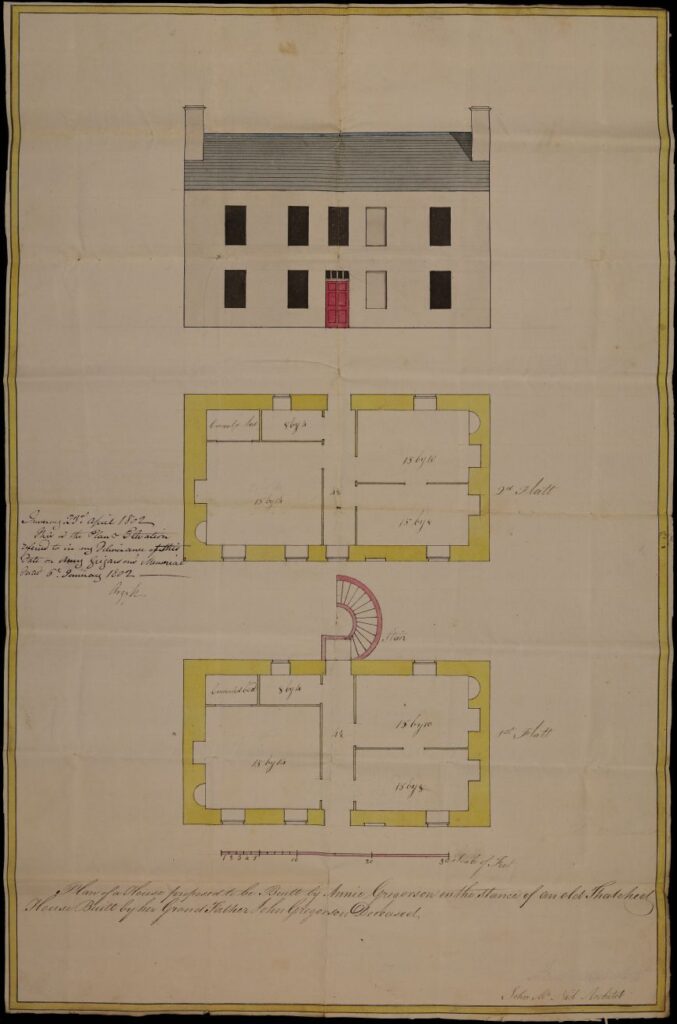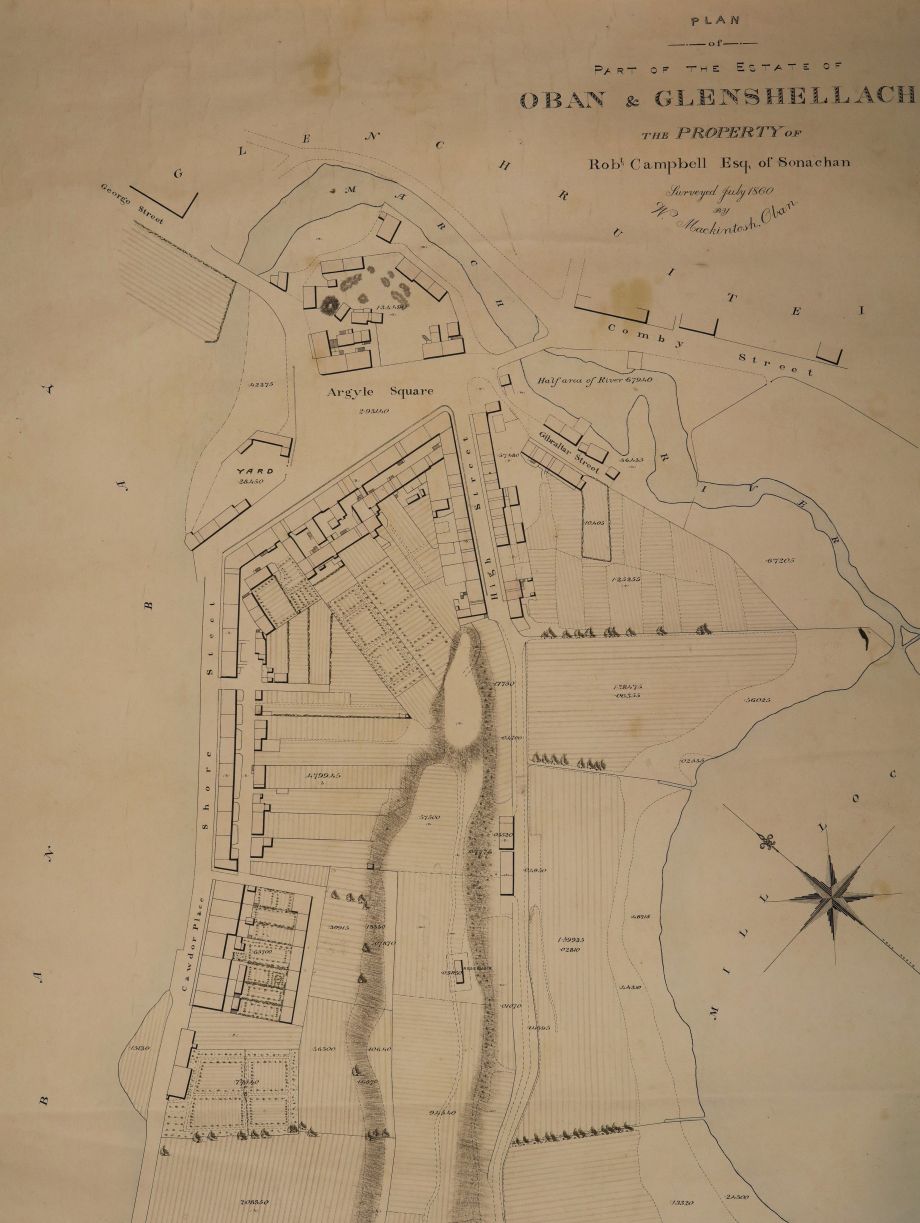Your cart is currently empty!
Amongst the many stories contained in Argyll Estates Archives is that of the early days of Oban. The original ‘village’ of Oban grew up around the natural, sheltered harbour, with the land owned by the Duke of Argyll on the south side and the Laird of Dunstaffnage on the north side. A report compiled by the Duke of Argyll’s chamberlain in 1792 provides a fascinating insight into the development of the village and the tussle between Argyll and Dunstaffnage over whose land the settlement should be laid out on.
‘It is said,’ writes the Chamberlain, ‘that about twenty years ago the only Houses in Oban were the Custom house, a small thatch’d Publick House and another Hut – the Inhabitants were then only two or three Families – now there are above Fifty Houses already built and building, from one to three stories high, and the Inhabitants amount to above 650 souls – and new settlers are every week coming in’. There are now, of course, around 8,500 inhabitants of the town of Oban.
‘The Harbour of Bay of Oban, which is about a mile in Breadth, is covered by the Island of Kerrera and sheltered by it from the violence of the westerly winds – vessels come in or go out at either end of the Island, as the wind or their course may direct – the Bottom or anchoring Ground is good, the Water is deep enough to permit vessels of any burden to lye near the Shore… but notwithstanding these favourable Circumstances, it still requires a Quay . . . to load & unload vessels with ease. The greatest Obstacle to the Improvement of Oban, as well as many other Parts of the Highlands, appears to be the high price of Fewel [fuel] or difficulty in procuring it – and Oban labours under both these disadvantages.
‘The Parish Church being four miles from Oban, the principal Inhabitants and others have begun a subscription for building a Church and endowing a Minister for themselves . . . Dunstaffnage is said to be very desirous to have the Church built on his side of the Water, and indeed to draw all the settlers over there – it is reported also that he endeavours to prove that his side of the Water ought properly to be called Oban, and that the south side ought not to be at all considered as Oban – in this however some old People, amongst others the Laird of McDougall, contradict him – but independent of this, the Custom house being upon the south side sufficiently establishes that as the Town and Port of Oban’.
Roads and bridges were then, as now, essential, but getting funding has always been a challenge. For the inhabitants of Oban it was a bridge that was needed, ‘which ought to be done out of the District Funds – but some of the Inhabitants express’d their hopes that your Grace would advance the money meantime.’ The bridge also needed to be built as soon as possible since ‘Dunstaffnage in endeavouring to prove his side of the water to be Oban has a view of directing the Publick Funds to the continuing the Road by the Rocks to his Village’. If the limited public funds were used to build the main route into Oban directly to the north side of the bay, then ‘it would not only withdraw that money that would be more justly and usefully applied in reparing the proper Roads, but it would put it out of the power of the Trustees to afford any aid towards building the Bridge so much wanted.’ It would also make the north side of the bay, Dunstaffnage’s part, eminently more accessible.
The Chamberlain draws attention to the need to support the shipping industry, ‘A Quay should be built near the Custom house, and all vessels be obliged to load and unload there.’ But there were other opportunities which, if a little financial and practical support were forthcoming, would provide further employment for the growing population. ‘For some time past Mr Dale of Glasgow has employed a number of weavers . . . and several Looms are at work (with Fly shuttles) on his & other manufacturers accounts in Oban & Glenshellich, under the direction of a young man named Alexr Gray . . . he is encouraged by a manufacturing Company in Glasgow to carry on the weaving on a more extensive Scale . . . praying that your Grace would provide the necessary Buildings.’
At the end of his report the Chamberlain has compiled ‘A List of the number of Men, women and Children now living in the the Village of Oban & wintertown of Glenshellich’, which shows the variety of trades and professions already established there. There were 40 masons and 30 joiners, potentially involved in building the new houses mentioned in the report; 25 weavers and 14 tailors to make clothing from the woven cloth; 26 sailors and, somewhat surprisingly, 16 shoemakers. The total population on the Duke’s side (the south side of Oban) was 584, with 89 people living on Dunstaffnage’s side. There were, as is mentioned above, 44 proper houses on the south side but only 8 on the north. And out of 28 registered vessels, 12 belonged to, and were built by, Hugh and John Stevenson. One suspects that these figures were provided to prove once and for all that the village of Oban was essentially on the Duke’s land and not Dunstaffnage’s.
Find more of Argyll’s stories in Argyll Estates Archives at Inveraray Castle, open Mon to Fri by appointment. Email: archives@inveraray-castle.com. Tours, visits and workshops are also available, visit https://www.inveraray-castle.com/argyll-papers
To learn more about the development of Oban, see ‘The Early History of Oban in Maps, Charts, and Plans’ by T.A. Lennox (2024) – available from Waterstone’s bookshop, George Street, Oban.


Images:
- Plan and elevation of a house to be built by Annie Gregorson, 1802 (ref: NRAS/1209/3233)
- Detail from a plan of Oban and Glenshellach, surveyed by W. Mackintosh, 1860 (ref: ARG/12/2/99)

